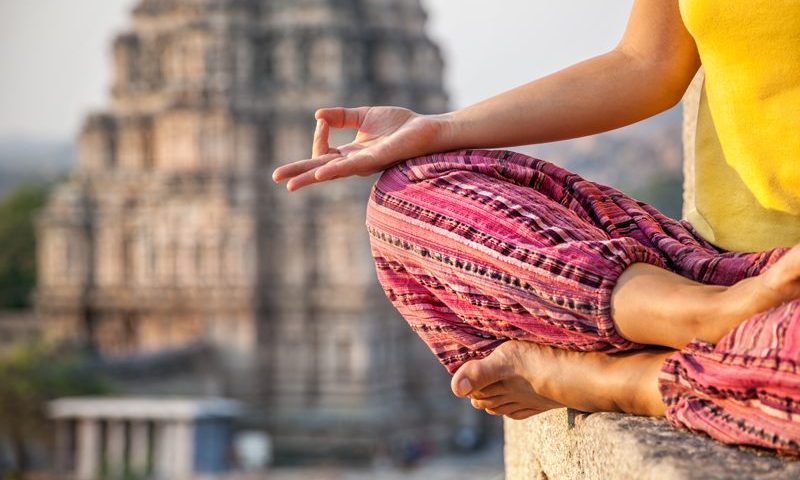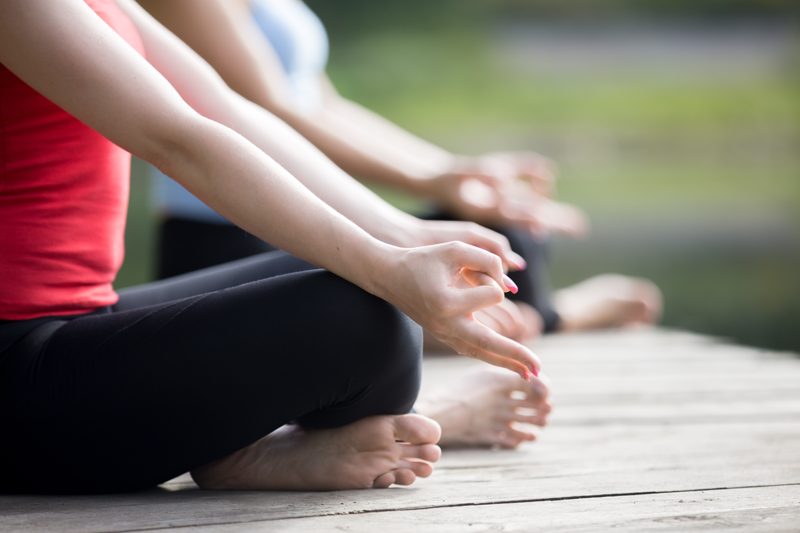
10 Foods You Didn’t Know Were Good for Your Skin
17th May 2019
What is Mula Bandha?
6th June 2019What is Dhyana Yoga?

Dhyana, the seventh limb of yoga, can be achieved by absorbing ourselves in the focus of meditation. The word “dhyana” comes from the Sanskrit word “dhyai”, which means “to think of”. If you attend a weekly yoga class, your instructor may teach a number of meditation techniques. However, these techniques are essentially just ways to help you focus, settle, and concentrate. Unbeknown to some, the practice of meditation is not something we can actively do; instead, it is the result of totally absorbing ourselves. When you are meditating successfully, you won’t be aware of the fact that you’re doing so. If you want to try Dhyana Yoga for yourself, put on your yoga hoodie and keep reading.
Dhyana in Practice
At first glance, Dhyana may seem difficult, or even impossible, to achieve. Most of us are practicing yoga to feel good, reduce our stress levels, or benefit our health. Achieving a permanent state of bliss can seem a little out of our league. While there’s no doubt that the concept is tricky, it’s manageable with regular practice.
The Yoga Sutra suggests that the purpose of meditation is to stabilize the fluctuations of normal mental activity. These include memory, sensory knowledge, and imagination. Out of these, memory is the hardest one to calm, as it constantly interrupts us with glimpses of the past and an endless array of thoughts and emotions. Much like the other limbs, Dhyana is a systematic process which takes practice and patience to learn. Some yogis compare it to training a puppy. To achieve Dhyana, you’ll need to train to your mind to come back to you when you call it and to stay still. Just like you would with a puppy, be gentle with your mind. Don’t expect too much too soon.
How to Start with Meditation
To achieve Dhyana, focus the mind on a particular object and practice becoming absorbed by it. You can choose any object that feels right for you. Some yogis like to use a body part, a beautiful object, or even a person you can focus on.
Once you’ve chosen your object, it’s time to prepare for the physical part of meditation. For best results, meditate shortly after some asana practice. This will ensure your body feels comfortable to sit completely still for a while. Get into a comfortable position, either sitting up or supported by a wall. While it’s important to be comfy, don’t get caught up in the physical posture. Providing that you can stay in this position for a while, it’s suitable. It’s also important to find a quiet space with no interruptions, particularly when you’re first starting out. To begin, focus on your object for just 5 to 10 minutes. Once you get used to the process, you can gradually increase the duration.
The Benefits of Dhyana
Dhyana has a number of benefits for the body and mind. The practice will release stress from the body, calm the mind, and allow us to feel more at ease. Over time, we’ll find more peace of mind in daily life by acknowledging the time between external events and our reaction to them. Dhyana also helps us to learn who we really are. When sitting in silence, we can have some much-needed alone time with our mind and connect with the soul.

Calming Dhyana Poses
Lotus Pose
- About the Pose: Lotus Pose is a meditative posture that reflects the spiritual connotation that a Lotus carries. The posture is an intermediate Hatha yoga asana. For best results, practice it in the morning before breakfast.
- Benefits: Lotus Pose has a number of benefits including increased energy levels. Additionally, the asana calms the brain and increases awareness and concentration. Physically, the pose keeps the spine straight and promotes correct posture.
- How to Practice: To practice Lotus Pose, sit on the floor with your legs extended and your back straight. Next, bend your right knee and bring it into your chest. Move your right ankle to the crease of your left hip with the sole of your foot facing upwards. The top of your foot should be resting on your hip. Next, bend your left knee and cross your left ankle over the top of your right shin. The bottom of your left foot should be facing upwards, with the top of your foot resting on your hip. Bring your knees as close together as possible whilst pressing your groins towards the ground. Rest your hands on your knees with your palms facing towards the ceiling. Bring your index finger and thumb together to create a circle, keeping the rest of your fingers extended. Finally, soften your gaze and bring it to your third eye, the space between your eyebrows. You are in Lotus Pose. Hold the asana for the duration of your Dhyana practice.
Cobra Pose
- About the Pose: Cobra Pose is an asana that reflects the raised hood of a snake. Best described as an energizing backbend, the posture is a beginner level Ashtanga asana. For best results, practice in the morning before breakfast.
- Benefits: Cobra Pose has a number of benefits including reduced stress and fatigue. The posture can also elevate your mood and invigorate the heart. When used regularly, Cobra Pose also increases the circulation of blood and oxygen throughout the body.
- How to Practice: To practice Cobra Pose, begin lying on your stomach. Extend your legs, keeping the tops of your feet on the floor. Next, place your hands flat on the ground directly under your shoulders. Slowly draw your elbows back into your body whilst pressing your thighs and the tops of your feet into the ground. Stay in this position for a couple of seconds and take time to concentrate on your breathing. When you are ready, slowly lift your chest off the ground by straightening both arms. Finally, press your tailbone firmly into the floor and engage your buttocks. You are in Cobra Pose. For best results, draw your shoulder blades towards your back and distribute the stretch evenly throughout the spine. Hold the asana for the duration of your Dhyana practice.
Seated Forward Bend
- About the Pose: Seated Forward Bend is a forward bend that stretches the whole body. The posture is a beginner level Hatha asana. For best results, practice Seated Forward Bend in the morning on an empty stomach.
- Benefits: Seated Forward Bend reduces anger, anxiety, and irritability. It also relieves stress, calms the mind, regulates blood pressure, and improves circulation.
- How to Practice: To practice Seated Forward Bend, begin seated with your legs together and your hands by your sides. Lift your chest and lower your upper body towards your legs. Engage your abdominals and imagine your stomach moving towards your thighs. You are in Seated Forward Bend. Hold the asana for the duration of your Dhyana practice.
In Summary
To achieve Dhyana, you need to absorb yourself in the focus of meditation. To do this, practice focusing on a particular object and becoming absorbed by it. At first, you may only be able to do this for a few minutes; however, it won’t be long before you can increase the duration and enjoy the benefits. If you’re struggling to focus, incorporate some yoga jewelry into your outfit. A mindfulness necklace will set the scene and help you to achieve Dyhana.

